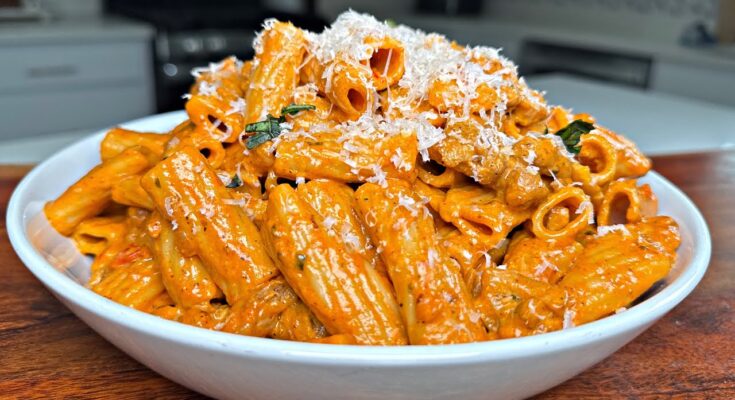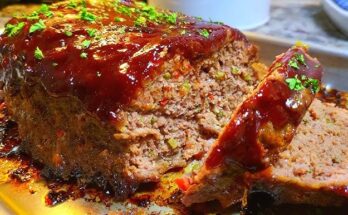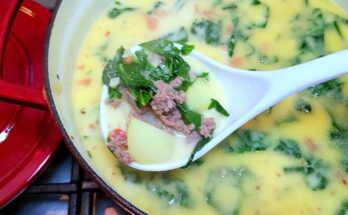Vodka Sauce Pasta Recipe: If you’ve ever wondered what happens when creamy, tangy, and savory flavors all come together in one luscious pasta dish, vodka sauce pasta is your answer. It’s rich but not heavy, tangy yet smooth, and full of layers that surprise your taste buds with every bite. This is the kind of recipe that feels restaurant-level fancy but is shockingly simple to whip up at home.
Vodka sauce is known for its velvety texture, mild kick from the vodka, and its perfect balance of creaminess and tomato flavor. Whether you’re making a romantic dinner, family meal, or meal-prepping for the week, this dish checks all the boxes. It’s comfort food with a bit of flair.
And no, you don’t need to be a professional chef—or even that experienced in the kitchen—to nail this recipe. With a few easy-to-follow steps and some simple ingredients, you’ll have a creamy, dreamy pasta dish that tastes like it came straight out of an upscale Italian trattoria.
What Makes This Recipe Stand Out
What makes this vodka sauce pasta different from the hundreds of versions online? It’s all about balance. Some recipes lean too heavy on the cream, making it overly rich. Others forget that the tomato base should still shine. Our version walks the tightrope beautifully. We’re also going deep into the how and why of every step—because great results come from understanding your ingredients, not just following a list.
This guide doesn’t just toss you a recipe. It walks you through the entire process, from prepping to plating, with pro tips and common pitfalls to avoid. Plus, we’ll throw in some killer variations and pairing ideas that make this more than a meal—it’s an experience.
Ingredients You’ll Need
Core Ingredients for the Vodka Sauce
Let’s start with the heart of the recipe—our silky vodka sauce. Here’s what you’ll need to build that base flavor:
- Olive oil – For sautéing and flavor depth.
- Unsalted butter – Adds richness and blends well with the olive oil.
- Shallots (or onions) – Finely chopped for sweetness and aroma.
- Garlic – The more, the merrier (well, within reason!).
- Tomato paste – This is key for deep, concentrated tomato flavor.
- Vodka – A small amount does wonders for flavor and texture.
- Heavy cream – To create that signature creamy texture.
- Salt & pepper – For balance and enhancement.
- Red pepper flakes – Optional, but adds a subtle heat.
- Parmesan cheese – Freshly grated for finishing.
- Fresh basil or parsley – Adds freshness at the end.
Every ingredient has a role. Tomato paste gives intensity, cream mellows the acidity, and vodka pulls flavors together in a way that water or broth simply can’t.
Pasta Choices – Best Types to Use
You’ve got options here, but some pastas work better than others when it comes to holding onto that luscious sauce:
- Penne – Classic and reliable. Those little tubes trap the sauce beautifully.
- Rigatoni – Bigger tubes, more sauce. A fan favorite.
- Fusilli – All those twists are perfect for catching creamy goodness.
- Tagliatelle or fettuccine – Flat pastas give a different texture but still work well.
Avoid thin pastas like angel hair. They tend to get lost in a sauce this rich and flavorful.
Optional Add-Ons and Toppings
Want to customize it a bit? Here’s what you can toss in without messing up the integrity of the dish:
- Cooked chicken or shrimp – For a protein boost.
- Sautéed mushrooms – Adds umami depth.
- Peas or spinach – A splash of green for freshness.
- Truffle oil – Just a dash for luxury.
- Mozzarella or burrata – For the ultimate cheese pull.
Kitchen Tools and Equipment
No fancy gadgets needed—just solid basics:
- Large saucepan or skillet
- Pasta pot
- Wooden spoon or silicone spatula
- Measuring cups and spoons
- Grater (for cheese)
- Strainer or colander
Optional but helpful: a blender if you like your sauce ultra-smooth (not necessary if you’re using finely chopped ingredients).
Step-by-Step Guide to Making Vodka Sauce Pasta
Step 1: Prepare Your Ingredients
Before you even turn on the stove, set yourself up for success. Gather 1 pound of pasta (like penne or rigatoni), 2 tablespoons olive oil, 3 cloves garlic (minced), ½ cup vodka, 1 cup heavy cream, 1 cup tomato paste or crushed tomatoes, 1 small onion (diced), ½ teaspoon chili flakes, salt and pepper, and grated Parmesan. Chop your herbs — basil or parsley — for that final flourish.
Step 2: Sauté Aromatics for Flavor Foundation
Heat olive oil in a large skillet over medium heat. Add diced onions and cook until translucent, about 3–4 minutes. Toss in the minced garlic and chili flakes, stirring until fragrant — careful not to burn it. This forms the flavor backbone of your sauce.
Step 3: Add Tomato Paste and Cook It Down
Stir in tomato paste and let it cook for 5–7 minutes, stirring often. The paste should darken slightly and caramelize — that’s your cue that it’s unlocking deep, rich flavors.
Step 4: Deglaze the Pan with Vodka
Pour in the vodka carefully (watch for steam!) and stir to deglaze the pan, scraping up any flavorful bits. Let it simmer for 2–3 minutes to burn off the alcohol, leaving behind a subtle bite that balances the richness.
Step 5: Simmer the Sauce with Cream
Lower the heat and slowly whisk in the heavy cream. The sauce will turn a beautiful blush pink — smooth, velvety, and luxurious. Season with salt and pepper to taste. Simmer gently for another 5 minutes.
Step 6: Cook the Pasta Al Dente
Boil your pasta in salted water until al dente. Save about a cup of pasta water before draining.
Step 7: Combine Pasta and Sauce
Add the drained pasta directly into the skillet with your sauce. Toss well, adding small splashes of reserved pasta water until the sauce clings perfectly.
Step 8: Finish with Cheese and Fresh Herbs
Sprinkle generously with grated Parmesan and top with chopped basil or parsley. Serve hot — creamy, tangy, and just a touch boozy. That’s restaurant-level vodka pasta, right from your kitchen.
Pro Tips for Perfect Vodka Sauce Pasta
Getting the Right Consistency
Achieving the ideal sauce texture is about finding that sweet spot between too runny and too thick. The cream should coat the back of a spoon without dripping off, and the sauce should cling to the pasta instead of pooling at the bottom of the bowl.
Here’s how to dial it in:
- If it’s too thick: Add reserved pasta water, a tablespoon at a time.
- If it’s too thin: Let it simmer uncovered for a few more minutes to reduce.
- Use freshly grated cheese instead of pre-shredded—it melts better and helps thicken naturally.
- A small pat of butter at the end adds a glossy finish and makes it feel luxurious.
How to Balance Acidity and Creaminess
Vodka sauce is a balancing act. The tomato paste brings sharp acidity, while cream and butter soften it. But too much of either can throw it off.
Here’s what helps:
- Heavy cream over milk—it stands up to the tomato’s acidity.
- Tomato paste instead of canned tomatoes for deeper flavor.
- A pinch of sugar can smooth out any overly tangy sauce (but only if necessary).
- Taste as you go—your palate will tell you what’s missing.
Make It Spicy – Or Not!
Vodka sauce traditionally has a subtle kick, but you can dial the heat up or down based on your preference. Want it hotter?
- Add extra crushed red pepper flakes
- Stir in a touch of Calabrian chili paste
- Use hot paprika or cayenne pepper
Want it mild? Skip the flakes altogether. The richness of the cream and Parmesan will still carry the flavor beautifully.
Common Mistakes to Avoid
Overcooking the Pasta
One of the most common and heartbreaking mistakes is overcooking the pasta. When pasta becomes too soft or mushy, it doesn’t hold sauce well and loses that satisfying bite. Remember, pasta continues to cook slightly even after it’s drained and especially once it’s tossed in hot sauce.
How to avoid it:
- Always cook your pasta 1–2 minutes less than the package instructions if you’re going to finish it in the sauce.
- Taste it! Don’t rely solely on the timer.
- If you’re cooking for a crowd and worried about timing, shock it in ice water for a few seconds after draining to halt the cooking process, then reheat in sauce.
Having perfectly cooked pasta means every bite delivers both texture and flavor—it makes all the difference.
Using Too Much Vodka
Yes, vodka is in the name—but too much of it, and you’ll ruin the balance. Vodka’s role in this dish is to enhance flavors, not overpower them.
Too much vodka can:
- Make the sauce taste overly sharp or bitter
- Prevent the sauce from properly emulsifying
- Leave an unpleasant alcohol aftertaste
Stick to the recommended ¼ cup (60 ml), and always simmer it for at least 2–4 minutes after adding, so the alcohol burns off and leaves only its subtle flavor-enhancing magic behind.
Skipping the Simmering Time
We get it—you’re hungry. But rushing the sauce is a big mistake. That 8–10 minutes of simmering after the cream goes in is where everything blends together, thickens, and turns from “just OK” into “lick-the-bowl” delicious.
What happens when you skip simmering:
- The sauce stays too thin
- Flavors don’t have time to meld
- The vodka may not fully cook off
Letting the sauce simmer gently allows all the ingredients to marry into one cohesive, rich, and silky masterpiece.
Variations of Vodka Sauce Pasta
Vegetarian Version
Good news: vodka sauce is naturally vegetarian if you use cheese made without animal rennet. The base recipe contains no meat and is already loaded with flavor.
To boost protein and texture in a vegetarian version, try:
- Sautéed mushrooms – earthy, hearty, and a great meat substitute
- Chickpeas or white beans – add creaminess and fiber
- Grilled or roasted vegetables – zucchini, eggplant, and bell peppers add color and flavor
For a richer finish, you can top the dish with a dollop of whipped ricotta or slices of fresh mozzarella.
Vodka Sauce with Chicken or Shrimp
Want to add some protein? You’ve got plenty of options. The creamy tomato base pairs beautifully with both chicken and shrimp.
- Grilled or sautéed chicken breast: Slice thin and toss it in at the end.
- Pan-seared shrimp: Cook separately with garlic and olive oil, then add on top before serving.
To keep things juicy, avoid overcooking the meat or seafood. For chicken, aim for an internal temp of 165°F (74°C). For shrimp, pull them as soon as they’re pink and firm—usually just 2–3 minutes per side.
This transforms your vodka pasta into a hearty main course without adding much extra work.
Dairy-Free and Vegan Options
Craving that vodka sauce vibe but avoiding dairy? No problem.
Dairy-free substitutes:
- Full-fat coconut milk or cashew cream instead of heavy cream
- Nutritional yeast or vegan Parmesan for cheesiness
- Olive oil instead of butter
Use your favorite plant-based pasta, and just like that—you’ve got a creamy, tangy vegan vodka pasta that’s just as comforting and flavorful.
For the vodka, make sure it’s gluten-free and vegan (most are, but it’s always worth checking the label).
Pairing Ideas – What Goes Well with Vodka Sauce Pasta
Side Dishes
Pasta is the star, but a good supporting cast makes the meal even better. Here are some perfect side dishes to round out your vodka sauce pasta:
- Garlic bread or crusty Italian bread – to mop up every last bit of sauce
- Caprese salad – fresh mozzarella, tomatoes, and basil complement the creamy sauce
- Roasted vegetables – asparagus, Brussels sprouts, or green beans for a healthy crunch
- Antipasto platter – olives, marinated artichokes, and cured meats to start things off right
Choose sides that contrast the richness of the sauce—think fresh, acidic, or crunchy.
Wine Pairings
Vodka sauce pasta may be Italian-American, but it still loves a good glass of wine.
Best wine pairings:
- Pinot Grigio – crisp and refreshing, cuts through the richness
- Chardonnay – a creamy match for a creamy sauce
- Chianti or Barbera – for red wine lovers who want a bit of acidity
- Prosecco – because bubbles make everything better
Stick to wines that balance the acidity of the tomatoes without overpowering the cream.
Salads and Breads
A well-dressed salad and fresh bread take your pasta dinner to the next level.
- Arugula salad with lemon vinaigrette: spicy, peppery greens balance the creamy pasta.
- Caesar salad: if you’re craving something bold and garlicky.
- Homemade focaccia or breadsticks: the ultimate comfort food side.
Don’t be afraid to serve a small starter course. It makes your home-cooked meal feel like a special event.
How to Store and Reheat Leftovers
Storage Tips
Got leftovers? Lucky you. Vodka sauce pasta actually tastes even better the next day, once the flavors have had time to meld even more.
Here’s how to store it properly:
- Let it cool to room temperature before refrigerating.
- Store in an airtight container.
- It’ll keep in the fridge for 3–4 days.
Want to freeze it? Absolutely. Freeze just the sauce (not the pasta) in a freezer-safe container or bag for up to 2 months. When ready to use, thaw overnight in the fridge and reheat gently.
Reheating Without Ruining Texture
Reheating pasta can be tricky—nobody wants gummy noodles or broken sauce.
Reheating tips:
- Add a splash of water or cream before reheating to loosen the sauce.
- Warm it gently in a skillet over medium-low heat, stirring often.
- Microwave in short bursts (30 seconds at a time), stirring between intervals.
If the sauce seems too thick, that splash of pasta water (or just plain water) does wonders. If it feels too flat, brighten it up with a squeeze of lemon or a fresh sprinkle of Parmesan.
Nutritional Information (Approximate)
Here’s a rough breakdown per serving (based on a standard portion of sauce + pasta, without added proteins):
| Nutrient | Amount per Serving |
|---|---|
| Calories | ~580–620 kcal |
| Carbohydrates | ~60–65g |
| Protein | ~12–15g |
| Fat | ~30–35g |
| Saturated Fat | ~18g |
| Fiber | ~4g |
| Sugar | ~7g |
| Sodium | ~400–500mg |
Keep in mind, adding chicken, shrimp, or cheese will boost protein and fat. Using whole wheat or high-protein pasta can also modify the nutrition profile to fit your goals.
FAQs about Vodka Sauce Pasta Recipe
1. Can I make vodka sauce without vodka?
Yes, you can. Substitute the vodka with a mix of water and a splash of white wine vinegar or lemon juice. It won’t be quite the same, but still delicious.
2. Is vodka sauce alcoholic?
Very minimally. Most of the alcohol cooks off during the simmering process, leaving only a subtle depth of flavor. The final dish is safe for most people, including kids.
3. How long does homemade vodka sauce last?
In the fridge, it lasts 3–4 days. In the freezer, just the sauce (without pasta) can last up to 2 months when stored in an airtight container.
4. What type of pasta is best for vodka sauce?
Penne and rigatoni are classics because their shapes hold onto the creamy sauce well. But fusilli, fettuccine, and even gnocchi work great too.
5. Can I freeze vodka sauce pasta?
It’s best to freeze the sauce separately and cook fresh pasta when you’re ready to eat. Cooked pasta tends to get mushy when frozen and reheated.
Conclusion
Vodka sauce pasta is the kind of dish that turns a regular dinner into something unforgettable. It’s creamy, comforting, and a perfect blend of indulgent and elegant. Whether you’re cooking for yourself, your family, or to impress a date, this recipe delivers every single time.
With the right balance of ingredients, a bit of patience, and the step-by-step process we’ve shared, you’ll never need to rely on jarred sauce again. And the best part? You can tailor it exactly to your liking—from spicy to mild, vegetarian to protein-packed.
So pour a glass of wine, grab a fork, and dig into one of the best comfort foods out there.


